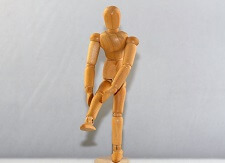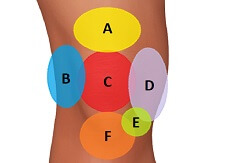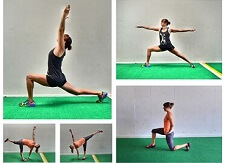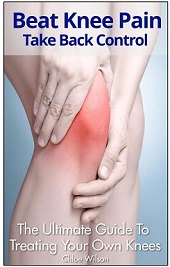- Home
- Common Knee Injuries
- Hamstring Strain
Pulled Hamstring Muscle
Written By: Chloe Wilson, BSc(Hons) Physiotherapy
Reviewed by: KPE Medical Review Board
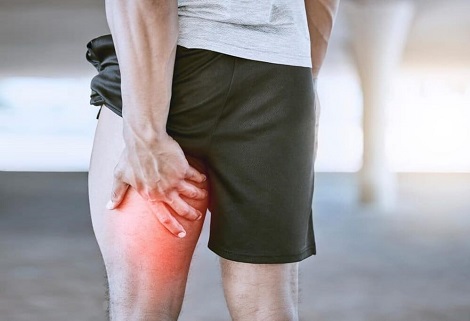
A pulled hamstring is a very common sporting injury.
It is caused by sudden overstretching or overloading of one of the muscles on the back of the thigh resulting in hamstring pain.
There are three different grades of hamstring strain, depending on the severity of the injury. Mild to moderate cases of a pulled hamstring will usually recover in 4-8 weeks, but more severe hamstring injuries can take 3-6 months.
There is often a tendency for people to return to sports too quickly following a pulled hamstring muscle leading to a high recurrence rate, but this can be avoided with the right rehab.
Here we will look at what the different grade of hamstring strains are and how they occur, common symptoms of a pulled hamstring, the best treatment options and how to make a full recovery.
What Is A Hamstring Strain?
A pulled hamstring is when one of the hamstring muscles gets overloaded or overstretched, causing some of the muscles fibres to tear.
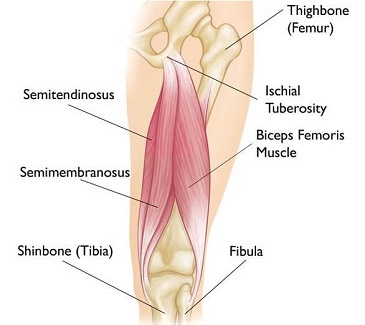
There are three hamstring muscles on the back of the thigh that run from the pelvis to the knee:
- Semimembranosus: the most medial hamstring muscle on the back of the thigh
- Semitendinosus: sits underneath the semimembranosus muscle
- Biceps Femoris: the outer hamstring muscle on the back of the thigh
The hamstring muscles work together to bend the knee and extend the hip. Most hamstring injuries occur in the muscle belly (the thick, central part) or at the junction between the muscle and the tendon, known as the musculotendinous junction.
There are three grades of hamstring tear:
- Grade 1 Hamstring Strain: a mild pull or strain where only a few muscle fibres are torn
- Grade 2 Hamstring Strain: a partial muscle tear where around 50% of the muscle fibres are torn
- Grade 3 Hamstring Strain: a complete tear aka hamstring rupture or torn hamstring
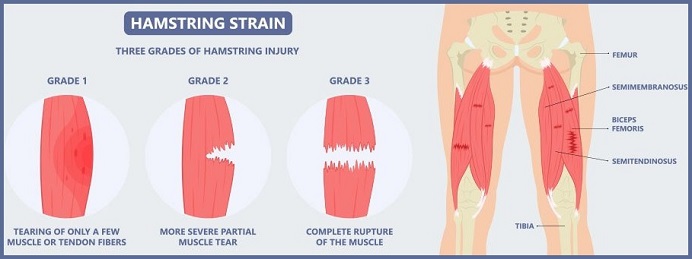
Occasionally, the hamstring tendon may actually tear off from where it attaches to the bone, and may even pull a fragment of bone with it. This is known as an avulsion fracture and accounts for approximately 12% of pulled hamstring injuries.
What Causes Hamstring Injuries?
A pulled hamstring muscle usually occurs during sudden, powerful leg movements when one or more of the hamstring muscles are:
- Suddenly Overstretched: forcefully stretched beyond the elastic limit
- Suddenly Overloaded: with a force that it is too strong for the muscle to cope with. With a pulled hamstring this usually occurs when the muscle tries to make a quick, forceful contraction that it doesn’t have enough strength for e.g. jumping or rapidly changing direction
Hamstring injuries are the most frequently experienced injuries in sport, accounting for approximately 12-15% of all injuries in athletes. Common causes and risk factors for hamstring injuries are:
- Sprinting At High Speeds: During explosive acceleration or top-speed sprinting, the hamstrings undergo significant stress, especially during the late swing phase when the leg is extending forward. The sudden, forceful contraction combined with the high demands placed on the muscle can increase the risk of hamstring strains
- Overstretching During Kicking: Sports activities that involve repetitive and forceful kicking motions, such as soccer, can lead to hamstring tears. Overstretching the hamstring muscles while extending the leg forcefully, especially if done without proper warm-up, can result in hamstring strains
- Jumping And Landing: Jumping activities that require quick and powerful leg extension, like in basketball or volleyball, followed by a landing can put the hamstrings under immense eccentric stress. Inadequate control or landing mechanics can contribute to hamstring tears
- Deceleration And Change Of Direction: Activities that involve sudden changes in direction, such as cutting, pivoting, or agility drills, can result in a pulled hamstring. The rapid eccentric contraction and deceleration required to control the body's movement, stabilise the knee and change direction can overload the muscle-tendon complex, leading to strains
- Overtraining Or Fatigue: Pushing the hamstrings beyond their capacity without adequate rest and recovery can increase the risk of strains. Continuous high-intensity activities or repetitive motions without sufficient rest periods can fatigue the muscle, making it more susceptible to injury
- Insufficient Warm-Up: Failing to warm up properly before engaging in intense physical activities can increase the risk of hamstring strains. A thorough warm-up routine helps prepare the muscles, increase blood flow, and improve muscle elasticity, reducing the likelihood of a pulled hamstring injury
- Muscle Weakness/Tightness: Strength deficits in the hamstrings make them more prone to overloading and less able to cope with the stress of exercise. Decreased flexibility in the hamstrings increases the risk of the muscle being overstretched
- Muscle Imbalance: between the hamstrings and quadriceps, can increase the risk of hamstring injuries. When the hamstrings are weaker or less flexible compared to the quadriceps, it creates an uneven distribution of forces around the knee joint during activities like running or jumping. The stronger quadriceps overpower the relatively weaker hamstrings, leading to excessive strain on the hamstring muscles and tendons. This imbalance compromises shock absorption, stability, and movement mechanics, making the hamstrings more susceptible to injury
- Previous Injuries: people who have pulled a hamstring in the past are much more likely to experience further hamstring tears. Studies have shown that people are 2-6 times more likely to experience hamstring injuries if they had a pulled hamstring in the past and the re-injury rate is around 22-34% within 1 year
- Age: Adolescents are particularly prone to hamstring injuries during growth spurts as their bones grown faster than the muscles can lengthen, leading to increased tension through the muscle. People over the age of 40 are also at increased risk of a pulled hamstring as muscles lose strength and become more rigid with age
Whilst muscle strains can affect any muscle, hamstring injuries are particularly common due to the fact that the muscles cross two joints, the knee and the hip, and also the way they have to work in many situations by contracting eccentrically. We will look at this in more depth at the end of the article.
Pulled Hamstring Symptoms
Hamstring strain symptoms will vary depending on the grade of the injury:
Grade 1 Hamstring Strain
A mild pulled hamstring muscle usually results in:
- Mild discomfort and tightness in the back of the thigh.
- Minimal swelling or bruising
- Mild hamstring pain during movement, particularly when stretching or contracting the hamstring muscles
- No significant loss of strength or function
Grade 2 Hamstring Strain
A moderate pulled hamstring usually causes:
- Moderate to severe hamstring pain in the back of the thigh
- Noticeable swelling, bruising, or discoloration
- Difficulty with walking, running, or other activities that involve the hamstring muscles
- Reduced range of motion and flexibility
- Significant loss of strength and power in the leg
Grade 3 Hamstring Strain
Common symptoms of a complete hamstrings rupture are:
- Intense hamstring pain at the back of the thigh, potentially causing difficulty in weight-bearing.
- Extensive swelling, bruising, or discoloration.
- Severe limitations in mobility and difficulty performing simple movements.
- Marked loss of strength and function, with difficulty in fully contracting the hamstring muscles.
- Possible palpable gap or defect in the muscle.
In some cases, there may be a tearing or popping sound or sensation in the back of the thigh at the time of injury with a torn hamstring. Swelling, bruising and tenderness from a pulled hamstring muscle tends to develop over a few hours – more quickly with grade 3 hamstring tears.
Diagnosing Hamstring Injuries
Your healthcare provider, typically a doctor or physical therapist will take you through the diagnostic process for a pulled hamstring which will involve:
- Taking A History: They will ask you about your symptoms, how the injury occurred, and any previous history of hamstring strains. This information helps in understanding the nature and potential causes of the injury.
- Physical Examination: They will then perform a thorough physical examination, focusing on the affected area. This will involve assessing your range of motion, strength, and flexibility in the hip, knee and calf region. Palpation of the area may be done to identify specific points of tenderness or muscle defects.
- Special Tests: Specific functional tests may be performed to assess the strength, stability, and coordination of the leg, such as squatting, lunging and performing single-leg movements. Specific tests e.g. Thomas test and active and passive ROM tests will help to identify any areas of muscle tightness. These tests help to evaluate the impact of the injury on functional abilities and identify any associated muscle imbalances or compensations.
- Imaging Studies: In some cases, imaging studies may be ordered to confirm the diagnosis or rule out other possible causes of pain. X-rays will show if there is an avulsion fracture. Ultrasound or Magnetic Resonance Imaging (MRI) are commonly used to assess the severity of the injury, visualize the extent of muscle or tendon damage, and determine the grade of the hamstring strain.
The diagnostic process aims to accurately determine the grade and severity of the pulled hamstring prior to commencing treatment.
Pulled Hamstring Treatment
Hamstring strain treatment will depend on the grade of injury that you have and your own needs, but the goal is to get you back to doing all the activities you were enjoying before your hamstring injury. Most hamstring tears can be treated effectively at home, but more severe grade 2 and 3 hamstring tears may involve more intervention.
Treatment for a pulled hamstring usually involves a combination of:
1. RICE
RICE treatment stands for rest, ice, compression and elevation and is the best place to start with a pulled hamstring muscle, whatever the grade
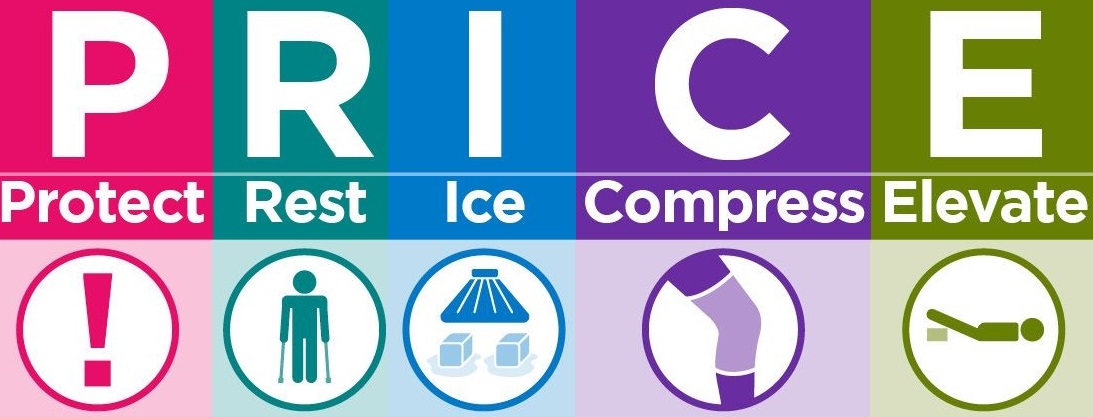
- Rest: Stop doing whatever activity you were doing when your symptoms started immediately. You will need to take it easy for a few day – limit the amount of walking you do and avoid any activities which aggravate your symptoms to reduce the risk of further injury. With grade 2/3 tears, you may need to use crutches and/or a knee splint for a few days
- Ice: regularly applying an ice pack to a pulled hamstring helps to reduce pain and inflammation and can help speed up the healing process. Be sure to wrap the ice in a towel and apply for 10-15 minutes, every 2-3 hours. Start using ice as soon as possible after your injury for maximum benefit
- Compression: wearing an elasticated tubigrip compression bandage helps to reduce swelling in the area and will provide some support. But be aware, they should not be worn over night
- Elevation: keeping the leg elevated while you rest can help to reduce swelling. Ideally lie down and prop your leg up so the injured area is higher than your heart for maximum benefit
2. Medications
Over-the-counter medications can be used to help reduce pain and inflammation from a pulled hamstring. Painkillers such as paracetamol/acetaminophen are usually a good place to start. Anti-inflammatory medications such as ibuprofen/Advil should be avoided for the first 2-3 days as taking NSAID’s too early can actually slow down healing as it inhibits the necessary initial inflammatory response.
3. Physical Therapy
Physical therapy is a really important part of treatment of hamstring strains. Your therapist may use a range of hands-on treatments such as:
- Deep Tissue Massage: helps to realign the muscle fibres as they heal and improve flexibility
- Acupuncture: can help to reduce pain and inflammation and promote healing following a pulled hamstring injury
- Taping: can help to off-load the injured muscle and improve flexibility which helps to reduce the risk of re-injury
- Therapeutic Ultrasound: helps to reduce pain and inflammation by increasing circulation, reducing muscle spasm and increasing the extensibility of collagen fibres
- Rehab Program: they will give you a specific, guided exercise program to follow throughout your recovery
4. Exercise Equipment
You may find it helpful to use some exercise equipment as part of your pulled hamstring treatment:
- Static Bike: in most cases, you can start using a static exercise bike just a few days after a pulled hamstring muscle. Start with no resistance so you are just getting the movement through your hip and knee without overloading the injured muscle. You may need to change the seat height to avoid stretching the muscle – be guided by pain. Start off with short periods of around 5-10 minutes. After around 3 weeks you can start adding in some resistance and gradually increase how long you cycle for and by 12 weeks you can be working at moderate to high intensity training
- Treadmill: for the first 3 weeks, stick to low intensity pain-free speed and stride. After 3 weeks, you can progress towards moderate to high intensity work, but it still within pain-free speed and stride. After 12 weeks you can work at moderate to high intensity as tolerated, and can add in inclines.
5. Torn Hamstring Surgery
In severe cases of a pulled hamstring muscle, typically with an avulsion fracture or occasionally for a grade 3 torn hamstring, then surgery may be required to reattach the tendon to the bone or repair the torn muscle.
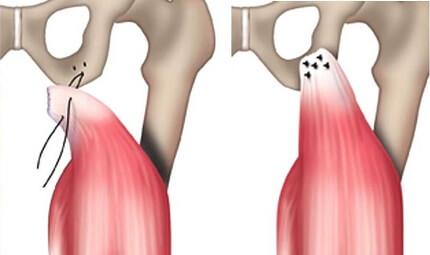
During hamstring tendon avulsion surgery, the surgeon will pull the hamstring back into place and remove any scar tissue that has formed.
They will then reattach the tendon to the bone using anchors, typically traction sutures or staples.
Hamstring tendon avulsion injuries are much more common at the pelvis (proximal tendon avulsion) than at the knee (distal tendon avulsion).
Ideally, surgery should be carried out within 4 weeks of injury to reduce the risk of tendon retraction (shortening) and scar tissue formation.
Hamstring Strain Exercises
One of the most important parts of treatment following a pulled hamstring muscle is exercises to regain the strength and flexibility in the injured muscle, but it is important to strike the right balance. Pushing yourself too hard and returning to intense exercise too quickly can exacerbate the injury and hinder the healing process. On the other hand, avoiding exercise for an extended period can lead to muscle atrophy and the formation of scar tissue around the tear in the hamstring muscles.
Finding the appropriate level of activity and gradually progressing pulled hamstring exercises in a guided manner is crucial for optimal recovery.
1. Hamstring Strengthening Exercises
The best place to start with hamstring strain exercises is with isometric strengthening exercises. Isometric exercises are where you work the muscle without any associated movement, so the muscle contracts without changing length.
In the initial phase of healing, the injured hamstring tissues ability to handle tension is temporarily reduce and it is important not to overload the muscle. But you don’t want to stop using the muscle altogether as it will very quickly lose strength and start to waste (atrophy). Isometric exercises give you the most control on how much stress is applied to the healing tissue. Isometric exercises can usually be started 3-5 days after a pulled hamstring injury.
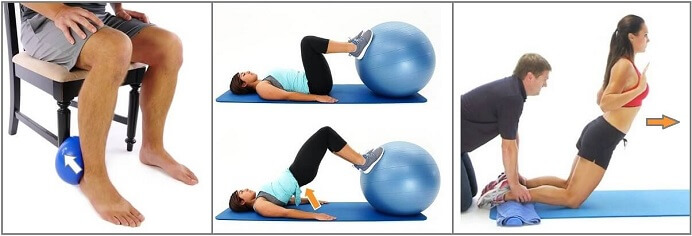
To start with, you should work the hamstring muscle with pain-free isometric contraction progressing to around 50-75% of its maximum resistance – don’t be tempted to push it as hard as you can initially. Aim to work the muscle in a range of positions between 30, 60 and 90 degrees of knee/hip flexion.
After around 3-6 weeks following a pulled hamstring, you can start to progress onwards, adding in some knee and hip movement to your hamstring strengthening exercises with exercises such as hamstring curls, bridging and squats. You will gradually be able to increase the number of repetitions, being guided by pain. You can then add in resistance work, the simplest method being to use resistance bands so you can control the level of resistance going through the healing hamstring muscle.
Around 12 weeks after a hamstring tear, you can progress to doing strengthening exercises through the full range of motion at the hip and knee and work on functional training for returning to sport e.g. plyometrics, sprinting and acceleration/deceleration work. You should also work on eccentric muscle training which is vital for reducing the risk of re-injury. A common example of eccentric hamstring strengthening exercises is Nordic exercises.
2. Hamstring Stretching Exercises
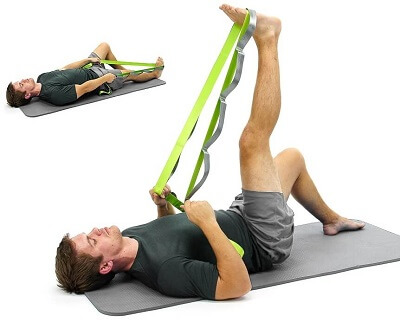
It is important to avoid excessive stretching of injured hamstring muscles for the first 3 weeks.
As the muscle heals, the damaged fibres will start to knit back together by newly forming collagen fibres bridging the gaps.
If you put too much strain through the fibres with stretching, you will pull these fibres apart, slowing the healing process – similar to picking a scab. So it is important in those first 3 weeks only to move the muscle through its pain-free range.
After around 3 weeks, you can start doing some gentle hamstring stretches, but avoid pushing into end range pain. As the pain-free range gradually increases, you can start stretching further and by 12 weeks, you should be able to take stretches right to end range.
3. Balance Exercises
It is really important to build up the stability and control in the leg following a pulled hamstring injury with some balance exercises. The best place to start is simply standing on one leg, which you should be able to as soon as you can comfortably stand. Aim to spend a few minutes doing this 2-3 times a day. Once you feel confident doing this, try closing your eyes – you will find it much more challenging!
After around 3 weeks, you can add in some movement such as throwing/catching a ball while standing on one leg and then gentle reaching exercises, commonly known as windmill touches.
By 12 weeks, you can really start challenging yourself e.g. by using weights and being on an unstable surface as you do balance exercises. It is really important to get your balance back to pre-injury level or ideally even better to reduce the risk of a further pulled hamstring injury
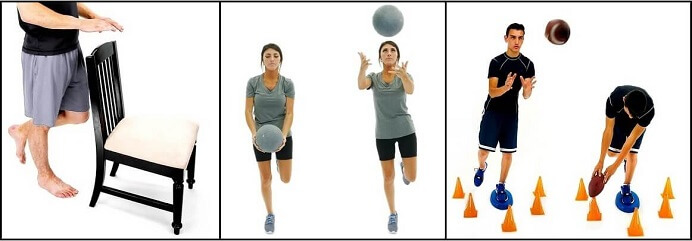
Pulled Hamstring Recovery Time
Hamstring strain recovery time will vary depending on the severity of the injury and individual factors. Generally, mild to moderate hamstring strains will take about 2 to 8 weeks to heal. However, severe grade 3 hamstring tears can take several months for complete recovery.
People are often tempted to return to sports and their pre-injury exercise levels too quickly which explains the high recurrence rate of pulled hamstring injuries.
Before returning to sports you should have:
- Full pain-free range of motion at the hip and knee
- Full pain-free strength in lengthened hamstring position
- Less than 5% concentric and eccentric strength deficit
- Be able to replicate all sport-specific movements at competition level without any symptoms e.g. squat jumps, backward skips, single leg bounding, bounding and depth jumps and zigzag hops
- Excellent balance and neuromuscular control at trunk, pelvis, knee and ankle
Why Are Hamstring Injuries So Common?
We’re going to get a bit technical here, so feel free to skip this part if you’re not interested in the inner workings of muscle contractions! There are two things that make the hamstring muscles particularly prone to injury:
- Position: the hamstring muscles cross two joints rather than just one
- Eccentric Contractions: where the hamstrings lengthen whilst under tension
These can be a bit tricky to get your head round, but let me try and explain.
Firstly, the position of the hamstrings muscles mean that they work across two joints, the hip and the knee. Muscles than cross two joint are much more susceptible to injury than single joint muscles.
With a single joint muscle, the tension through the muscle is controlled by movement at just one joint. But with a two joint muscle, the tension changes with movement at both joints, and motion at one joint increases the passive tension in the muscle. For example, if the hamstrings were a single joint muscle e.g. only worked to bend the knee, then it wouldn’t make any difference what position the hip was in, the hamstrings would simply contract to bend the knee, and relax to allow the knee to straighten.
But because the hamstrings run across the hip as well, the amount of tension in the hamstring muscle as it contracts and relaxes will be changed by whether the hip is bent forwards or extended back. If the hip is bent, the hamstring will be in a more lengthened position (stretched) than if the hip is extended. If you then try and extend the knee, the hamstrings have to lengthen (stretch) even further. The hamstrings are therefore under greatest tension (stretch) when the hip is bent and the knee is straight. This is a common position when running, as you stretch the leg forward, just before the foot hits the ground.
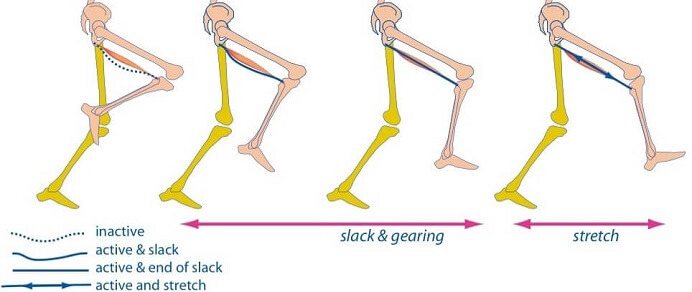
Secondly, hamstring strains tend to occur when the hamstrings are lengthening as they work, known as eccentric contraction. Normally, we think of muscles working concentrically i.e. as they get shorter, they pull on a joint, making it move further the more they contract e.g. with a bicep curl, the biceps muscle contracts to bend the elbow up.
But with an eccentric contraction, the muscle lengthens as it controls the movement e.g. as you lower the bicep curl back down, the biceps muscle has to lengthen in a controlled manner so the arm doesn’t just flop down. Muscles actually have to work harder to work eccentrically than concentrically, meaning there is more tension through a muscle as it lengthens than as it shortens.
The combination of these two factors places a great deal of strain through the hamstrings during certain movements and activities increasing the risk of a pulled hamstring injury, particularly with:
- Jumping: taking off and landing
- Kicking: e.g. football or martial arts
- Running: sudden acceleration, deceleration, pivoting, changing direction or running downhill
These all require eccentric work from the hamstrings in a lengthened position due to hip and knee position, increasing the risk of a pulled hamstring injury.
Pulled Hamstring Summary
Hamstring strains are the most common sporting injury affecting one of the three hamstring muscles on the back of the thigh.
There are three grades of hamstring tear, relating to the severity of damage.
A pulled hamstring injury occurs when the hamstrings are suddenly overstretched or overloaded.
Treatment for hamstring strains usually involves a combination of RICE, medications, physical therapy, strengthening and stretching exercises, rehab program and occasionally surgery.
The risk of re-injury is high following a pulled hamstring injury with around 22-34% of people suffering another hamstring strain within one year.
You may also be interested in the following articles:
- Pain Behind The Knee
- Quadriceps Tendonitis
- Knee Strengthening Exercises
- How To Do Stairs With Knee Pain
- Knee Pain From Running
- Swelling Above The Knee
Page Last Updated: 05/07/23
Next Review Due: 05/07/25
Related Articles
References
- Internation Journal Of Sports Physiotherapy. Hamstring Injury Rehabilitation And Prevention Of Reinjury Using Lengthened State Eccentric Training: A New Concept
- Rheumatology Journal. Therapeutic Ultrasound In Soft Tissue Lesions
- Arthroscopy Techniques Journal. Repair of Proximal Hamstring Tears: A Surgical Technique
- Journal Of Sports Sciences. Is There Really An Eccentric Action Of The Hamstrings During The Swing Phase Of High Speed Running? Part I: A Critical Review Of The Literature
